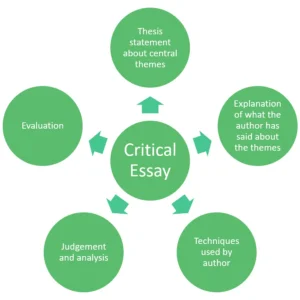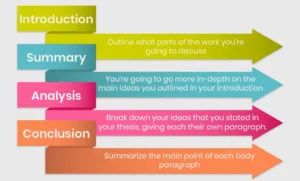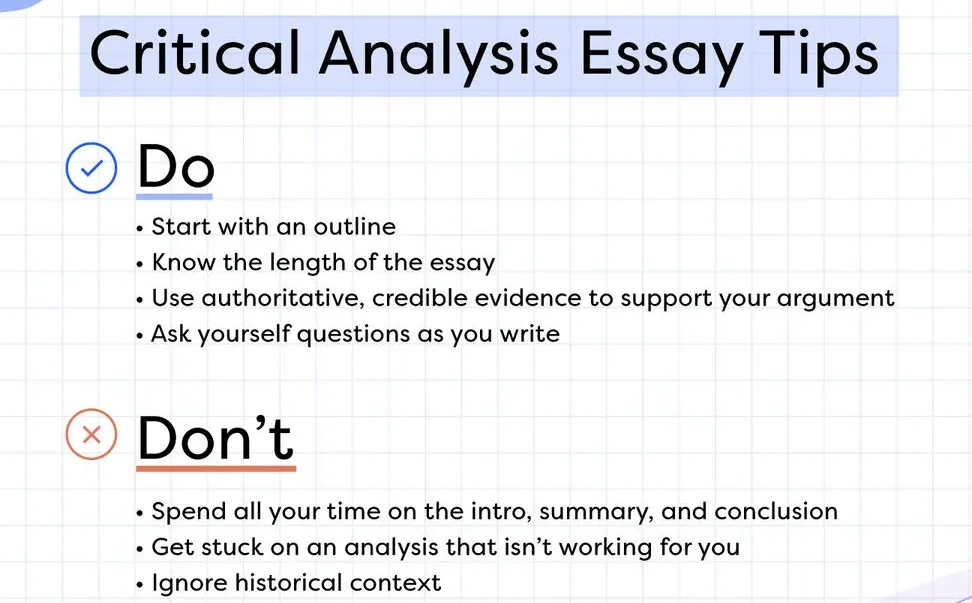Do you find yourself struggling when it comes to academic writing? Are you often faced with the challenge of understanding and evaluating complex texts, whether they are literary works, artworks, or scientific papers? You’re not alone. Many students and scholars grapple with this exact issue.
The critical analysis essay is here to help. It’s like a secret weapon that can empower you to tackle these daunting tasks with confidence. This type of essay allows you to dive deep into a text, break it down into its parts, and thoughtfully assess it. Whether you’re deciphering the meaning of a book, unraveling the mysteries of a painting, or critically examining a scientific study, mastering the skill of critical analysis is a game-changer.
In this guide, we’re going to address this challenge head-on. We’ll walk you through the key elements of a critical analysis essay and provide you with practical steps to become an effective writer. So, if you’ve ever felt overwhelmed by the prospect of dissecting complex material, keep reading – we’ve got you covered.
What is a Critical Analysis?

Before diving into the intricacies of writing a critical analysis essay, let’s start by understanding what it actually means.
Definition: A critical analysis essay is a piece of academic writing that evaluates, interprets, and critiques a specific work, such as a book, film, painting, or research paper. It goes beyond summarizing and involves a thorough examination of the work’s elements to form an informed opinion or judgment.
Why Write a Critical Analysis Essay?
-
Develop Critical Thinking:
Writing a critical analysis essay is like a mental workout for your critical thinking skills. It compels you to think deeply, beyond the surface of the subject matter. You’re not just accepting information at face value; you’re questioning it, dissecting it, and considering it from multiple angles. This process of critical thinking enables you to develop a sharper, more analytical mind. It teaches you to ask essential questions: What is the author trying to convey? How are they doing it? What evidence supports their claims? What might be missing or overlooked? These questions cultivate your ability to think critically, a skill that is immensely valuable in solving problems, making informed decisions, and engaging in meaningful discussions.
-
Enhances Writing Skills:
A well-structured critical analysis essay is a testament to your writing prowess. It demands clarity, coherence, and effective communication of your ideas. As you analyze a subject, you must articulate your thoughts concisely and logically. This process refines your writing skills, making you a more effective communicator. This ability is not limited to academic settings; it extends to professional environments where clear and persuasive communication is paramount. Whether you’re crafting reports, proposals, or business emails, the writing skills honed through critical analysis essays will serve you well.
-
Engages with the Subject:
When you embark on a critical analysis essay, you’re not merely skimming the surface of a topic. Instead, you dive deep into the subject matter. You explore the nuances, the subtleties, and the hidden layers that may not be immediately evident. This immersive engagement allows you to gain a profound understanding of the subject matter. You become an active participant in the learning process, and this deeper connection with the material enriches your overall education. Moreover, it can foster a genuine passion for the subject, making learning more enjoyable and meaningful.
-
Contributes to Scholarship:
In the realm of academia, critical analysis essays play a significant role in advancing knowledge and scholarship. They contribute to ongoing discussions and debates in various fields. Your analysis might shed new light on a previously unexplored aspect of a work, challenge established theories, or offer fresh perspectives. Through your critical insights, you become a part of the scholarly conversation, adding your voice to the chorus of thinkers who seek to expand our collective understanding. This contribution is not only intellectually rewarding but also holds the potential to shape the direction of future research and inquiry.
Essential Components of a Critical Analysis Essay

A successful critical analysis essay consists of several key components. Let’s break them down.
1. Introduction
The introduction serves as the opening of your essay and should provide some crucial information:
- Hook: Start with an engaging hook or attention-grabber that entices your readers to continue.
- Context: Provide context for the work you’re analyzing. Mention the title, author, and any relevant background information.
- Thesis Statement: State your main argument or thesis. This should be a clear and concise statement that previews what your analysis will focus on.
2. Summary
After the introduction, offer a brief summary of the work you’re analyzing. Keep it concise and to the point, highlighting the key plot points, main arguments, or central themes.
3. Analysis
This is the heart of your critical analysis essay. Break down the work into its essential components, and analyze each of them individually. Here are some elements to consider:
- Literary Devices: If you’re analyzing literature, discuss the use of literary devices such as symbolism, metaphor, or foreshadowing.
- Themes: Identify and explore the central themes and ideas presented in the work.
- Characters: Examine the characters’ development, motivations, and roles in the narrative.
- Structure: Analyze the structure of the work, including the organization of ideas, chapters, or scenes.
- Argumentation: If you’re analyzing an argumentative text, evaluate the strength of the arguments presented.
4. Evaluation
In this section, provide your evaluation and assessment of the work. Discuss its strengths and weaknesses. Here are some questions to consider:
- Did the author achieve their goals or objectives?
- Were the arguments convincing?
- How effective was the use of literary elements?
- Did the work contribute to the broader field of study?
5. Conclusion
Summarize your main points and restate your thesis in the conclusion. Offer a final assessment and, if appropriate, suggest the significance of the work in a broader context.
How to Outline and Write a Critical Analysis Essay

Now that we’ve discussed the essential components, let’s explore the step-by-step process of outlining and writing a critical analysis essay.
Step 1: Choose Your Work
The first step in writing a critical analysis essay is selecting the work you will analyze. This choice is crucial, as your passion for the subject matter will greatly influence the depth and quality of your analysis. You can also choose to take help from expert essay writing services available online. Consider an example where you are tasked with analyzing a classic novel: “To Kill a Mockingbird” by Harper Lee.
In this case, your choice of this influential novel allows you to explore themes of racial injustice, morality, and empathy. Your passion for these themes will drive your analysis, making it more engaging and authentic.
Step 2: Research
Once you’ve chosen your work, gather relevant information to provide context for your analysis. For example, if you’re analyzing George Orwell’s “1984,” delve into Orwell’s life, the political climate of the time, and the dystopian genre. Here’s an example of how research can provide valuable context:
“George Orwell, a British author writing in the aftermath of World War II, penned ‘1984’ as a warning against totalitarianism. His own experiences during the Spanish Civil War and his observations of authoritarian regimes deeply influenced the novel. Understanding Orwell’s background and the historical context in which he wrote the book is crucial for a comprehensive analysis.”
Step 3: Create an Outline
Organization is key in any essay, and a critical analysis essay is no exception. An outline helps you structure your thoughts and maintain a logical flow throughout your essay. Here’s an example of an outline for analyzing a documentary, such as “Bowling for Columbine” by Michael Moore:
I. Introduction
II. Summary
III. Analysis
IV. Evaluation
V. Conclusion
Step 4: Write the Introduction
The introduction, often considered the cornerstone of your essay, plays a crucial role. It must not only capture the reader’s attention but also provide essential context and present your thesis statement effectively. Here’s an example:
When diving into the complex topic of gun violence, Michael Moore’s documentary ‘Bowling for Columbine’ takes center stage. In a nation where this issue claims thousands of lives each year, the film fearlessly explores America’s intricate relationship with firearms. Through a blend of emotional interviews, sharp satire, and thought-provoking content, ‘Bowling for Columbine challenges viewers to confront the stark reality of gun violence. This analysis will delve into Moore’s persuasive techniques and assess the documentary’s impact on the ongoing discussion surrounding gun control. Discovering ‘How to Write an Essay Introduction‘ effectively sets the stage for an insightful exploration of this critical issue.
Step 5: Summarize the Work
In the summary section, offer a concise yet comprehensive overview of the work you’re analyzing. Focus on key points, major events, or central arguments. For instance, if you’re analyzing a scientific research paper, your summary might look like this:
“Dr. Jane Smith’s research paper on climate change analyzes the impact of rising global temperatures on polar bear populations in the Arctic. The study employs a combination of field observations and computer modeling to predict future trends. Smith’s findings indicate a significant decline in polar bear numbers due to diminishing sea ice habitat.”
Step 6: Analyze
In the analysis section, delve into the work, examining various aspects in detail. Use evidence from the work itself to support your analysis. If you’re analyzing a Shakespearean play like “Macbeth,” consider analyzing the character development of Macbeth himself:
“Shakespeare masterfully crafts Macbeth’s character as a tragic hero plagued by ambition and moral conflict. At the beginning of the play, Macbeth is depicted as a loyal soldier, but as his ambition for power grows, so does his descent into madness. His soliloquies, such as ‘Tomorrow, and tomorrow, and tomorrow,’ reveal the inner turmoil and guilt that drive his actions.”
Step 7: Evaluate
In the evaluation section, provide a balanced assessment of the work, discussing both its strengths and weaknesses. Consider the impact of the work within its context. For example, if you’re evaluating an art exhibition, your evaluation might look like this:
“While the art exhibition showcased a diverse range of contemporary artworks, its strength lay in its ability to provoke thought and spark discussions on social issues. However, some pieces lacked depth and failed to resonate with the audience. Overall, the exhibition succeeded in challenging traditional notions of art while leaving room for improvement in certain areas.”
Step 8: Conclude
As you bring your critical analysis to a close, remember the importance of the conclusion. Summarize your main points, restate your thesis, and provide your final insights. Here’s an example of a conclusion for an analysis of “The Catcher in the Rye” by J.D. Salinger:
“In summary, J.D. Salinger’s ‘The Catcher in the Rye’ remains a timeless exploration of teenage alienation and the quest for authenticity. Through Holden Caulfield’s journey, the novel speaks to the universal human experience of grappling with identity and societal expectations. Salinger’s vivid character portrayal and narrative voice continue to resonate with readers, establishing ‘The Catcher in the Rye’ as a literary classic that can provide valuable insights for those seeking Canada homework help.
Step 9: Revise and Edit
Review your essay for clarity, coherence, and grammar. Ensure your arguments are well-supported, and your writing is polished. Consider peer reviews or seeking feedback from professors or writing centers.
Step 10: Proofread
Finally, carefully proofread your essay to catch any spelling or grammatical errors. A polished essay not only conveys your ideas effectively but also demonstrates your attention to detail and commitment to excellence.
Additional Tips for Writing a Critical Analysis Essay

- Stay Objective: Maintain objectivity throughout your analysis. Avoid personal bias and emotions.
- Use Evidence: Support your claims with evidence from the work. Quoting and citing specific passages or scenes can strengthen your analysis.
- Consider Multiple Perspectives: Acknowledge and engage with different interpretations or viewpoints, even if you disagree with them.
- Edit and Revise: Writing is a process. Edit and revise your essay multiple times to improve clarity and coherence.
- Seek Feedback: Have someone else review your essay to get fresh insights and feedback.
- Follow Citation Style: If required, follow a specific citation style (e.g., APA, MLA) for your references and citations.
Frequently Asked Questions (FAQs)
Q1. Can I use first-person pronouns (I, me) in a critical analysis essay?
Yes, but use them sparingly and only when necessary. The focus should be on the analysis of the work, not your personal opinions.
Q2. How long should a critical analysis essay be?
The length can vary, but most critical analysis essays are typically around 1,000 to 2,500 words.
Q3. Do I need to provide a summary of the work in the introduction?
Yes, a brief summary in the introduction helps provide context for your analysis.
Q4. Can I analyze multiple works in one essay?
While it’s possible, it’s usually more effective to focus on one work per essay to provide in-depth analysis.
Q5. What’s the difference between a critical analysis and a book review?
A critical analysis delves deeper into the work’s components and evaluates its effectiveness, whereas a book review provides a summary and personal opinion on the work.
In conclusion, writing a critical analysis essay is a skill that can be honed with practice. By following the steps outlined in this guide and considering the essential components, you can become adept at critically analyzing a wide range of works in an academic or professional context. Happy writing!


